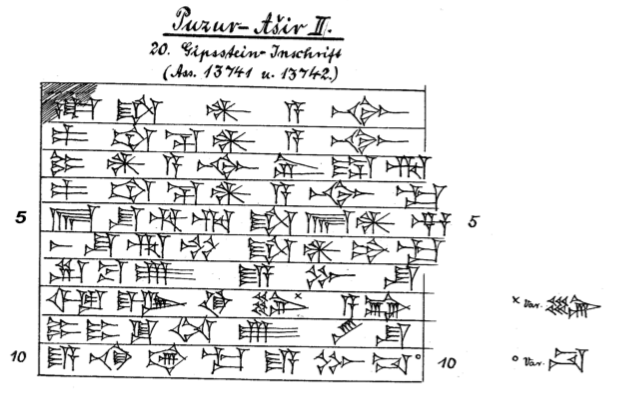Puzur-Aššur III
Puzur-Aššur III was the sixty-first ruler of Aššur according to the Assyrian King List [/riao/KingLists/AssyrianKingList/index.html] (AKL). He reigned for either twenty-four or fourteen years (ca. 1500 BCE; Streck 2006-08, 128). Nine inscriptions are attributed to him (text nos. 1-1001) and his building activities are mentioned in the royal inscriptions of several later kings: Aššur-bēl-nišēšu (text no. 1 [/riao/ria1/Q005706/]); Aššur-uballiṭ I (text no. 1 [/riao/ria1/Q005719/]); Adad-nārārī I [/riao/ria2/adadnararii/index.html] (text nos. 10 [/riao/ria2/Q005747/], 13 [/riao/ria2/Q005750/] and 15 [/riao/ria2/Q005752/]); Shalmaneser I [/riao/ria2/shalmaneseri/index.html] (text no. 6 [/riao/ria2/Q005794/]); Aššur-bēl-kala [/riao/ria3/ashurbelkala/index.html] (text no. 3 [/riao/ria3/Q005984/]) and Shalmaneser III [/riao/ria5/shalmaneseriii/index.html] (text no. 10 [/riao/ria5/Q004615]).
In recent years, new archaeological findings in the area of the confluence of the Tigris and the Lower Zab, and in particular the discovery of a new inscription (from two clay cones) at the site of Tall al-Farḥa (Miglus 2011; see, Text no. 8), recording the foundation of the city of Ḫabuba (Tall al-Farḥa itself), have increased our understanding of Puzur-Aššur's reign. In particular, these discoveries indicate the (previously unknown) wide geographical scope of Puzur-Aššur's building activities, which some scholars see (see, Miglus 2011) as an early formation of what would later blossom into the Middle Assyrian state, after achieving political independence from the Mittani.
Bibliography
Browse the RIA 1 Corpus [/riao/ria1/pager/]
1
An inscription of Puzur-Aššur III written on a clay cone found at Aššur records that this ruler renovated the wall of the Step Gate. The object is now housed in the Vorderasiatisches Museum (Berlin).
Access the composite text [/riao/ria1/Q005696/] of Puzur-Aššur III 1.
Bibliography
2

Ass 13742. Schroeder, KAH 2 no. 20
Two stone slabs discovered at Aššur bear an inscription stating that Puzur- Aššur III rebuilt the šuḫūru-room of the Assyrian Ištar temple. Ilu-šumma and Sargon I are said to have been previous builders of the temple. The current locations of the slabs are not known.
Access the composite text [/riao/ria1/Q005697/] of Puzur-Aššur III 2.
Bibliography
3
The beginning (the first six lines) of an inscription of an Assyrian ruler (probably Puzur- Aššur III) recording restoration work on a city gate at Aššur is known from a badly damaged clay cone. The object was found at Aššur and is now in the Eski Șark Eserleri Müzesi of the Arkeoloji Müzeleri (Istanbul).
Access the composite text [/riao/ria1/Q005698/] of Puzur-Aššur III 3.
Bibliography
4
The name of Puzur- Aššur III is preserved on a fragment of a clay cone from Aššur. The piece is currently in Istanbul (Eski Șark Eserleri Müzesi of the Arkeoloji Müzeleri).
Access the composite text [/riao/ria1/Q005699/] of Puzur-Aššur III 4.
Bibliography
5
A rim of a jar found at Aššur bears a proprietary label of Puzur- Aššur III. Its present location is not known.
Access the composite text [/riao/ria1/Q005700/] of Puzur-Aššur III 5.
Bibliography
6
A fragmentary clay knob with a cylindrical shaft had an inscriptions recording the works of Puzur-Aššur III on the great wall and on the gate of the New City, at Ashur. The fragment, which measures 16.5 × 11.5 cm and is said to have been "found by Fuad Safar in Tell Aqr off. Ruins of Sherqat" (Miglus 2010:236), has been mentioned in Borger, EAK 1 p. 20, and in RIMA 1, p. 90, but was edited only in 2010 by P.A. Miglus after an unpublished copy by D.O. Edzard.
Access the composite text [/riao/ria1/Q007686/] of Puzur-Aššur III 6.
Bibliography
7
This inscription, written on a fragment of a clay cone from Aššur, has been previously thought to have come from about the reign of Enlil-nāṣir I. The discovery of Puzur-Aššur III Text no. 6, however, has made possible the reconstruction of much of the lost lines and the new attribution. The text, of which parts of twelve lines are preserved, records, most probably, the works on the great wall and the gates of the Inner City. The piece is currently in the Eski Șark Eserleri Müzesi of the Arkeoloji Müzeleri (Istanbul).
Access the composite text [/riao/ria1/Q005703/] of Puzur-Aššur III 7.
Bibliography
8
Two clay cones are inscribed with the same text recording the foundation of the fortified city of Ḫabuba (Tall al-Farḥa), located on the right bank of the Lower Zab, close to area where it flows into the Tigris. The text resembles two other texts found on foundation documents from Ashur, nos. 1 and 6; especially the first five lines are identical to the first five and six lines of both texts. Also the formula ištu uššēšu adi šaptīšu ,"from the foundation to the top," is the same, whereas the "foundation documents" formula states "foundation documents and steles" (temmēnī u narê) instead of "my clay cone" (sikkatī).
The city of Ḫubaba, which appears already in texts from Nuzi (JEN 525 = JEN 670, HSS XVI 328 and BM 132.165), was one of the cities built on the frontier with Arraphe and Babylon, i.e. with defensive beside commercial purposes. After its foundation by the Assyrians, the city passed under the control of the kings of Arraphe in the 15th century. It was then reconquered after the end of Mittani's dominion and probably lost its importance in the 13th century after the collapse of the kingdom of Arraphe and the withdrawal of Babylonia southwards (Miglus 2011:228-229).
Access the composite text [/riao/ria1/Q007688/] of Puzur-Aššur III 8.
Bibliography
1001
A poorly preserved inscription written on a clay cone fragment from Aššur may be ascribed to Puzur- Aššur III. The attribution is based on the orthography of the name of the god Aššur and the reference to Ilu-šumma as a previous builder in line 2'; compare Puzur-Aššur III 2. The object is now in Berlin (Vorderasiatisches Museum).
Access the composite text [/riao/ria1/Q005701/] of Puzur-Aššur III 1001.
Bibliography
Nathan Morello, Jamie Novotny & Poppy Tushingham
Nathan Morello, Jamie Novotny & Poppy Tushingham, 'Puzur-Aššur III', RIA 1: Inscriptions from the Origins of Assyria to Arik-dīn-ili, The RIA Project, 2024 [http://oracc.org/OldAssyrianPeriod/Belu-baniDynasty/Puzur-AshurIII/]